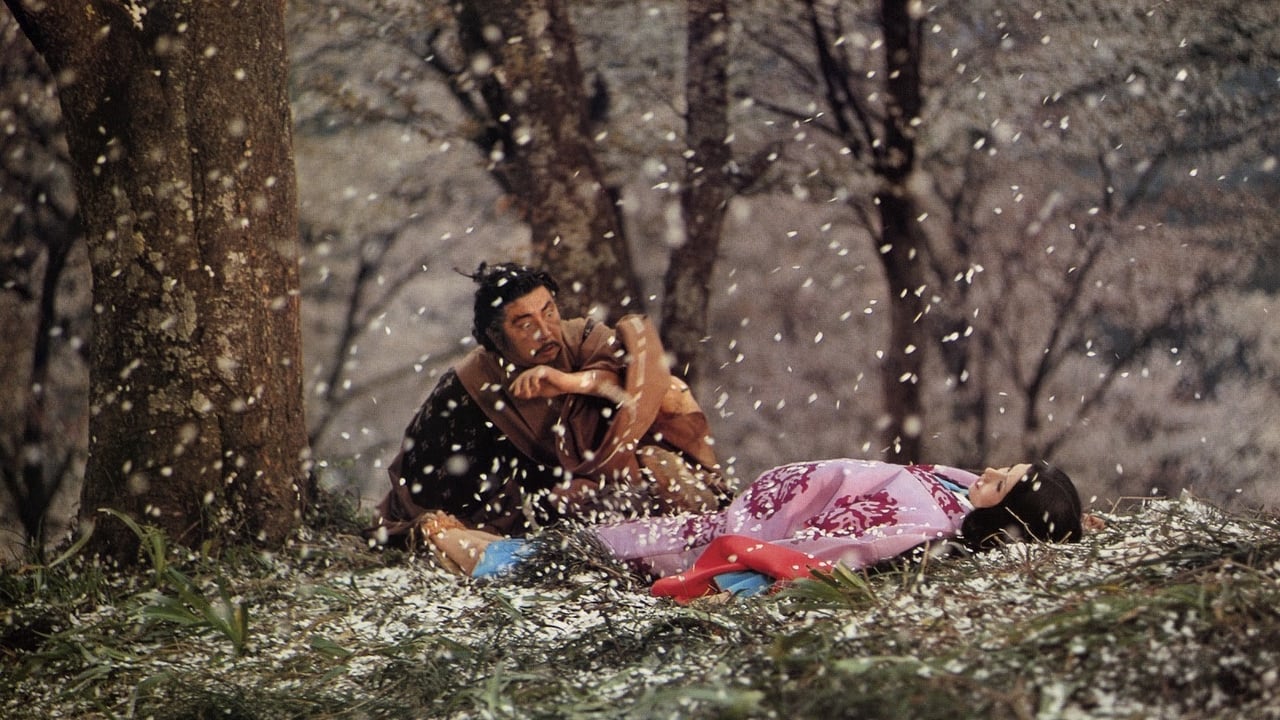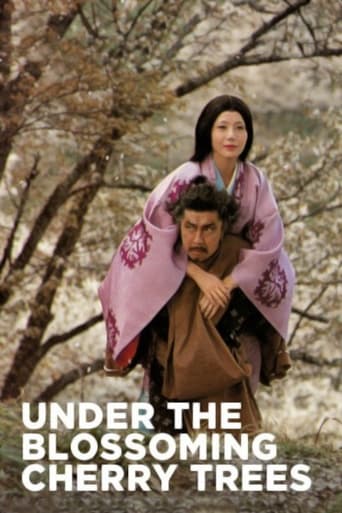

This is How Movies Should Be Made
... View MoreIt's no definitive masterpiece but it's damn close.
... View MoreA Major Disappointment
... View MoreIt's the kind of movie you'll want to see a second time with someone who hasn't seen it yet, to remember what it was like to watch it for the first time.
... View MoreUNDER THE BLOSSOMING CHERRY TREES / UNDER THE CHERRY BLOSSOMS (SAKURA NO MORI NO MANKAI NO SHITA). Viewed on Streaming. Subtitles = eight (8) stars; music/score = eight (8) stars; cinematography = eight (8) stars (exteriors); five (5) stars (interiors); lighting = five (5) stars; sound = five (5) stars. Director Masahiro Shinoda (also credited as co-writer) conjures up a stylistic fantasy about insanity caused by over dosing on Hanami (cherry blossom viewing) during a time before the onset of the Edo Period. Shinoda's plot objective is to show how sexual dominance/subservience role reversal can occur even under the strangest circumstances, and he uses the postulated mysterious impact of flower blossoming as a vehicle for progression. A mentally unstable wild-mountain-man and road bandit who usually murders travelers attempting to pass through "his" densely forested mountain of cherry trees encounters a stunning, demure, and shy "city woman" whom he promptly rapes and declares to be his common-law wife (after, of course, killing her husband and the rest of their party). Surprisingly, she readily agrees to this arrangement (the mental impact of flower exposure works fast!), becomes swept up by his passion, and agrees to become his "mountain woman" on the condition that he promptly eliminate (some by beheading) a collection of concubines saving one to be her maid. Not surprisingly, the city woman grows bored with mountain life, and, to amuse herself, reverts back to doll play where the "dolls" consist of a discriminating selection of decapitated heads (from former city dwellers she has known or known of) which her now-not-so-wild mountain-man obediently provides sans blood. With the reversal of roles apparently complete, the film ends rather abruptly (with a dissolve) that seems to indicate time and money ran out before the protagonists could run out (of the forest). Acting and direction are quite good. Lead actress Shima Iwashita (who is married to the Director) seems perfectly cast as usual. The male protagonist is allowed to "over inhabit" his part resulting in some ham here and there and slow intervals especially during the last third of the movie. Opening scenes include a fair amount of expository voice-over by a child actor for reasons the Director seems to keep to himself. Cinematography (semi-wide screen, color) is a mixed bag. Exterior shots of massive forests in full bloom are glorious. Interiors, however, are a bit on the dark side and "cry out" for deep focus so the viewer can simultaneously see foreground and background activities. Score is great with music that usually enhances scene impact. Sound is okay. Subtitles are especially well done. They appear to be reasonably accurate and well edited so that text length does not distract or compete with events (usually they can be read in a glance). A note of caution: there really could be something in those flowers and they are still out there, even more so! WILLIAM FLANIGAN, PhD.
... View MoreI watched this with "Professional Sweetheart." They have similar structure: a pretty girl and a rustic get involved in shows and the thing ends. In this case it ends tragically.And the show in this case is pretty gruesome. A pretty girl is captured by a rough robber who works alone. He takes her home for his wife. She turns into the wife from hell, trading what we see as great sex for increasingly more difficult favors. Then those favors escalate to demands to bring more and more severed heads for her to act out plays with. The heart of the film is her plays, her discovering that she is missing some character and sending her loutish but charmed husband out to get the head of a specific character: "the last monk wasn't mean enough looking."Meanwhile, we know that the cherry trees, when they blossom, magical curses affect those who wander through. This happens, and the falling petals are every bit as wonderful as you'll see in a Zhang film.The story is slow by western standards, but the structure is a western folded narrative spliced onto a traditional Japanese ghost story. The blossoming trees, the curse and the fantastic end with the air filled with petals and the smiling beauty dead, being caressed by the cherry blossoms is traditional. The business about explicitly constructed narrative (the head puppets) within the narrative is from the new wave influence sweeping Japan in that era.In both cases, the camera is extremely well managed. Space is essential, and one gets the idea that the story is only an excuse for the structure, and the structure is only an excuse for the visions. These are formally framed, and some of them are amazing. Visually, this is certifiably worth it.Ted's Evaluation -- 3 of 3: Worth watching.
... View More(there are a couple of mild spoilers in this review, but *nothing* that would really "spoil" the film) This is probably my favorite film out of the number of recently released Shinoda DVDs (R2 Japan, TOHO ltd. with English subtitles). Shinoda worked for Shochiku with a few of the other Japanese new wavers (in my opinion, giants of cinema) before the exodus into a more independent film-making, and in some ways he's the most conservative of the bunch (which is to say, not very conservative at all). Written by the extremely controversial author Sakaguchi Ango (an essay about his key work will be linked to at the end of the review) but to me this film didn't seem "politically" very daring at first glance. Though in a broader auteur context it does, like many Shinoda films, deal with woman's place in Japanese society in fact, it's largely a ghost story, fitting into a genre relatively defined (with a few notable examples being Kobayashi's Kwaidan, Jigoku, Mizoguchi's Ugetsu Monogatari, Shindo's Onibaba, and Kuroneko). You could call this genre a lyrical Twilight Zone riff, without the robust voice over work (usually), but more extremely stylized. Some of it's points are made very clear when you do some checking, which I'll get to a paragraph down.Beginning in present day (1975, in a park with people dancing and singing) with a child's voice telling the viewer that Cherry blossoms are now celebrated but we're told that before the Edo period, they were greatly feared, and to be under them alone would lead to madness. We're then brought hundreds of years into the past, through a forest of blossoming cherry trees, blossoms blowing in the wind, and breezes moving the branches as if breathing (unintended plentiful "B" use). It's easy to understand why they were feared, they seem mystical, powerful, and Shinoda presents them as a force. The plot is filled with a beautiful woman (Iwashita Shima, Shinoda's wife) bending a fairly unattractive, bloodthirsty and blustery man (Tomisaburo Wakayama, recognizable from Shinoda's Captive's Island a decade earlier) to her will. Many beheadings, murder, sexual perversion (I won't go into detail here, but there are some moments that will lead to serious eyebrow raising and head scratching), and ambitious city-dwelling fill the story. And falling right in line with the ghost story genre, you have your twist ending.You'll find a woman as man-eater ("Spider woman", that is) and man as a lust-filled animal, with plenty of tragedy thrown around. I call her a Spider-woman, yet unlike the category defining heroine of Imamura's Insect Woman, she does placate herself to a man's will at some point. She also holds up the definition in that she is sexually "free", and prone to putting pleasure at the foremost of concerns (these concerns become that of the audience as well, due to the morbid nature of her beast.) Sakaguchi wrote in his 1946 essay Darakuron ("On Decadence") that " both the Emperor System and Bushido state that 'the virtuous widow never looks at another man.' This prohibition itself is not merely inhuman, it directly contradicts human nature." At the beginning of the film, Shima's husband is killed by Wakayama, and she immediately adapts (in this way she exhibits strongly the qualities of the "spider-woman") and places herself at the "head of the table" in her new home. I suppose you could also read the subtext of the trees bringing madness as the old way of life, and Japaneseness, having a similar result. This point comes through even more clearly when a troupe of monks are seen flailing about as if under a spell.The cinematography is outstanding (maybe there's a listing for the individual responsible at jmdb), and the Takemitsu score adds to the dreamy flow of the film. I'll not soon forget the close-up of Iwashita with blossoms fluttering against her face as she smiles ambiguously. It's unfortunate that Desser dismisses the film as "minor", in my opinion it seems one of his best works (extremely accessible to those in need of exoticism, but a fantastic film no matter how you see it.) This, Himiko, and Ballad of Orin all seem to have similarities, which I'll give some thought to (I only have an unsubtitled version of Himiko, but it's fantastic to look at even though crippled by a language barrier).
... View More